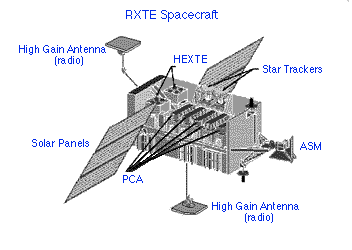Shedding a New Light on the Universe
Satellites and Their Parts
X-ray detectors are just one part of what makes up a satellite. They are a very important part - indeed they are the reason for having X-ray satellites! But we can't just stick an X-ray detector on a rocket and blast it off and expect it to work. Satellites need power and electricity, not only to run the instruments, but to move the satellite itself around. When we use a small telescope on the ground, we can manually swivel it around to the area of the sky we are interested in looking at. Because we can't do that to a satellite, we have to send it commands to rotate, so it can point its instruments in the direction we want them to see. In order to send commands up to the satellite, we need some sort of radio communications device. There is a lot that goes into designing a satellite, such as making sure it doesn't vibrate so much that the instruments get jittered around. The instruments have to be insulated from extreme heat and cold and designed to withstand the low pressure, zero gravity environment of space.
We can summarize the basic parts of a satellite and their functions.
|
Power - Electricity is needed for the instruments and to enable the spacecraft directional control. Power is provided by solar arrays in most cases, or, in cases like the recently launched, Saturn-bound, satellite, Cassini, where solar arrays do not supply enough power for planetary probes, nuclear generators are used.
|

|
Communication - The satellite has to communicate with ground control so directions and commands can be sent up and data sent down. To provide radio contact, satellites have radio antennae.
Guidance - Startrackers and gyroscopes help satellites align themselves in the right direction to acquire sources.
Science - Of course, satellites have scientific instruments on them!
What kind of orbits are scientific satellites put into? Usually they are put into low-Earth orbit, for example, RXTE is orbiting 570 km above us. It takes RXTE about 90 minutes to orbit the Earth once. The Hubble Space Telescope orbits at approximately 600 km and traverses the Earth once every 96 minutes.

Previous |

Next |


